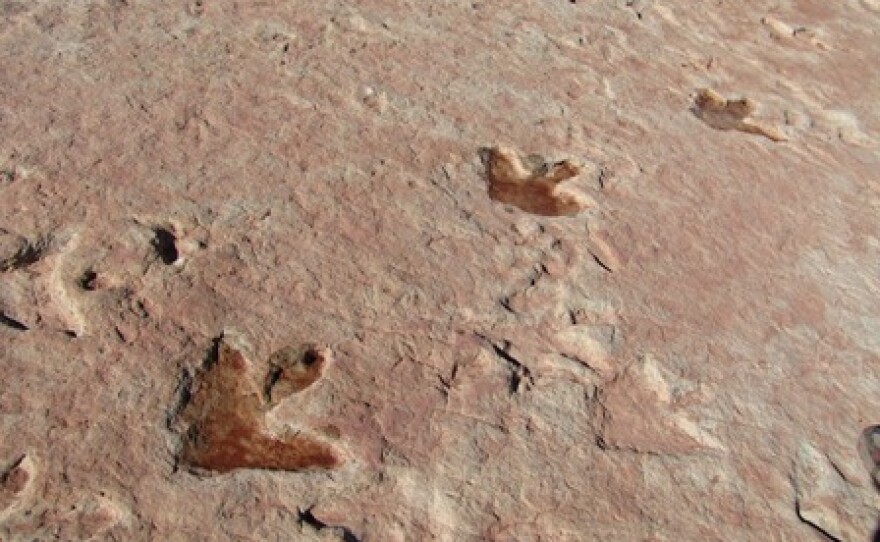TUBA CITY, Ariz. -- Travel east of Grand Canyon and take in the windswept mesas of Indian Country, and you might feel like you’re traveling back in time. That sense of timelessness intensifies when you find yourself off one dirt road just outside Tuba City -- at possibly one of the biggest dinosaur track sites in the country.
I’ve passed by the homemade signs dozens of times. “Dinosaur Tracks” and an arrow painted in red. When I pulled in, landowner and track tour guide Mark Haskie greeted me and told me to park in front of one of several jewelry stands. We walked pass the turquoise jewelry stands, the wind whipping against the colorful Navajo blankets on display.
"My grandma says it’s always been here, 80 years ago when she herd sheep out here," Haskie said. "My grandpa used to take (tourists) out here on horseback."
Haskie led me across the red sandstone mesa. He poured water into an enormous indentation in the rock -- a three toed footprint that he said was made by a Tyrannosaurus rex. He compared his foot to the track.
"I wear a size 12, look at it," Haskie said. "My foot looks tiny."
He took me to several fossils and prints of various sizes.
Tourists from around the world have stopped here to see the tracks. They pay anywhere from $10 to $40 for a guided tour. British traveler Adam Brown and his friends stopped on their way to Zion National Park.
"We just saw a sign for dinosaur tracks and we were really curious we thought we’d better stop by and take a look see what it’s all about," Brown said. "It’s pretty cool. I’m not sure how to take it."
While there have been many skeptics, the paleontologists I contacted said these tracks are indeed the real thing.
"I think it’s a fantastic track site," said Andrew Milner, a paleontologist in St. George, Utah. "From what I can see just kind of eyeballing it, there’s gotta be at least 200 dinosaur tracks."
He said this site could be one of the biggest in the country, but you need a permit from the Navajo Nation to study it thoroughly. He said the information guides are giving on the tour is not so reliable.
"When people visit the site you really need to take it with a grain of salt what some people may say," Milner said. "There’s some people that really don’t have a clue what’s going on there."
Milner said the T. rex track I saw couldn’t be a T. rex track. The tracks embedded in the hard sandstone were most likely made about 193 million years ago in a mudflat along a river and filled in and protected by super-fine sediment. The Tyrannosaurus rex didn’t show up until 85 million years ago.
But there was another infamous dinosaur whose tracks you can see.
"One of the most famous types of dinosaurs the one you see in Jurassic Park, which is really a poor representation of dilophosaurus. The name means two-crested lizard," Milner said. "We’re talking an animal 750 pounds to 1000 pounds. These are quite large meat eating dinosaurs."
The Haskies don’t have trouble with any predatory dinosaurs these days, but they’ve had a lot of problems with vandals coming out with rock cutters to steal large slabs of tracks from the Haskie land. So Mark and his family have taken turns guarding the tracks at night to keep people from stealing them. The Navajo Nation is building a new tourist center here with fences to protect the tracks.
Haskie said he's relieved. His six children have all moved off the reservation, so he said it’s time to retire. He’s grown weary of vandals, tourists and probably skeptics too.






